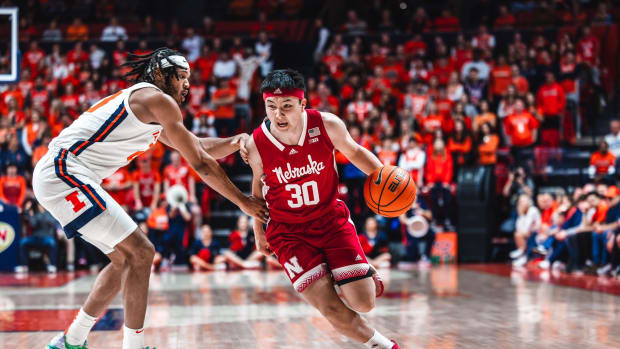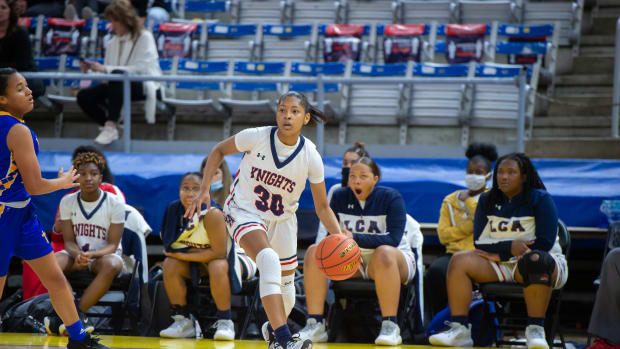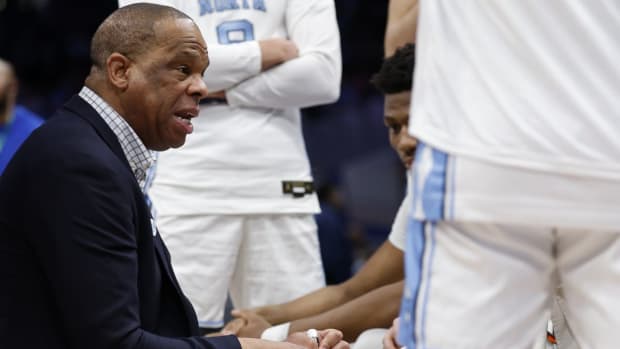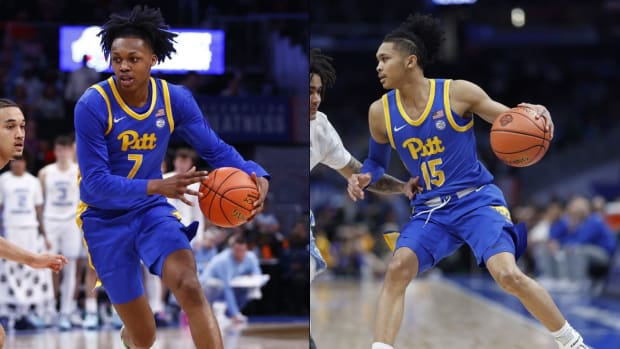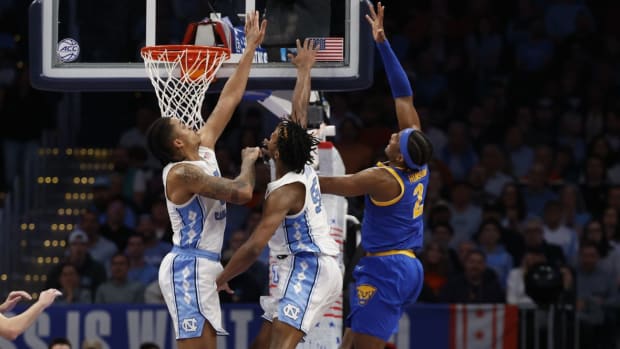The Magic Eight: One of These Teams Will Win the NCAA Tournament in 2019
Anyone can wait until the bracket comes out to take a stab at picking a national champion, and especially to pick eight possible options. But we here at SI.com, dating back to the time of soccer superscribe Grant Wahl’s days on the beat in the early 2000s, have traditionally taken on another challenge: selecting an eight-team pool from which the title winner emerge, a month or two in advance.
You have reached your limit of 4 premium articles
Register your email to get 1 more
Such is the premise for the Magic Eight. But it comes with a format designed to increase both intrigue and challenge. The rules: at least two of the top eight teams in the current AP poll must be excluded, and at least one selection must come from outside that poll’s top 15. Last February yours truly took the reins from the great Luke Winn and had the foresight to not only include Villanova but shout out sixth man and future Final Four MOP Donte DiVincenzo in my rationale. (Okay, I mentioned four Wildcats by name, but still.)
SINGLE: Duke Is Somehow More Inevitable and Unkillable Than Ever
Will this year’s iteration age as kindly, or will I crawl into the office come April and beg my bosses to scrub it from the internet, my very soul twisted in knots by shame? There’s only one way to find out. In lieu of your regularly scheduled Midweek Rebound programming, here is this year’s Magic Eight:
Duke (22–2, 10–1 ACC)
Not even the harsh realities of the clickbait economy can keep the Blue Devils off this list. Duke checks a lot of boxes for a potential national champ, from efficient balance on both ends (third nationally on offense, fourth on defense) to a wealth of pro talent to being coached by a Hall of Famer who has already won five championships—including one, in 2015, that was largely driven by ultra-talented freshmen. There are some areas of concern: Duke is not a great free-throw shooting team (68%), which could lead to some dicey late-game situations. The team’s 31.6% three-point shooting would be the worst by a national champion since the shot was introduced to college basketball in the 1986–87 season. (The current low was set by UConn in 2011, at 32.9%). But then there are games like Saturday’s at Virginia, when the Blue Devils caught fire and made 13 of 21 threes. If they can become a good shooting team? Hoo boy.
Virginia (21–2, 9–2 ACC)
Yeah, yeah. Nobody is going to feel very good about pinning their bracket’s hopes on the Cavaliers, whose years of tournament disappointment reached its zenith with last season’s unprecedented blowout first-round loss to UMBC. The knock on the Tony Bennett-era Hoos has been that while their formula (elite Pack-Line defense, glacially deliberate offense) has helped it dominate regular seasons and efficiency metrics, to paraphrase Billy Beane, their s--- doesn’t work in the playoffs. But this year Virginia is doing some different s---: with De’Andre Hunter (who missed the UMBC loss last year) blossoming into an NBA-bound star, the Cavaliers’ offense is better (No. 5 in efficiency) and more diverse and open than it’s ever been under Bennett. They can shoot (40.2% from three), they take care of the ball (the country’s 11th-lowest offensive turnover rate), and they’ll be as motivated as ever. Besides, only one of the last five national champions had made it past the NCAA tournament’s first weekend the year before; Villanova just went from perennial early-exiters to two titles in three years. Write off Virginia ad hominem at your own peril.
Tennessee (22–1, 10–0 SEC)
History raises some red flags for the Vols too. Tennessee has never even made the Final Four before and only once reached the Elite Eight, in 2010; coach Rick Barnes has made the season’s final weekend once, at Texas in ‘03, but his teams’ last seven NCAA tournaments have ended in the first or second round. But this team could very well be the best team to ever suit up for either Tennessee or Barnes, with two versatile, All-America caliber forwards in Admiral Schofield and Grant Williams and a combination of experience (sixth nationally in minutes continuity, per kenpom.com) and size (33rd nationally in height) that few can match. They assist on the country’s third-highest share of their field goals, they’re top-10 in free-throw shooting... but they’re going to have to defend better than their current 39th-ranked efficiency suggests. Opponents as unthreatening as Arkansas, Vanderbilt, and Texas A&M have had some of their best showings against the Vols. Similar lapses won’t help Tennessee—and Barnes—buck their reps.
Kentucky (20–4, 9–2 SEC)
Believe it or not, Kentucky is even less experienced than Duke, according to kenpom’s calculations, and are the fourth-youngest team in the country. The Wildcats’ weighted average of 0.64 years of experience would be even lower than the one-and-done-iest previous title teams, 2012 Kentucky (0.77) and 2015 Duke (1.06), and also 2011 UConn (0.94). But they do have two starters with at least some seasoning in Stanford grad transfer Reid Travis and sophomore PJ Washington and have quickly gelled into one of the nation’s very best defenses, a rather un-youthful quality. This Kentucky squad might not be loaded with lottery-bound prospects—only wing Keldon Johnson is currently projected in that range for this June, though Washington is rising—but this team is far from short on talent, and the ability of each of its top four scorers to shoulder the load on a given night is encouraging. The Wildcats are decent shooters (35.3% from three) but not overly dependent on treys (just 23.4% of their points), which can be a good combination.
SINGLE: LSU Knocks Off Kentucky and Demands Your Respect
Gonzaga (23–2, 10–0 WCC)
The Zags’ title hopes took a hit with the recent news that forward Killian Tillie, once expected to be perhaps their best player this season, is likely out for the rest of the regular season after tearing a ligament in his right foot, his second significant injury this injury and one that would presumably cast even his postseason contributions in some doubt. But Gonzaga was one of the country’s best teams in November and December, when Tillie was sidelined by an ankle malady, even beating Duke in Maui. That suggests the Bulldogs can survive Tillie being out or hobbled again, especially given the emergence of Rui Hachimura and Brandon Clarke as All-America talents and the team’s combination of size, experience and talent, with which few can compete. The defense, currently 21st in adjusted efficiency, is a bit below usual championship standards, but teams with elite offenses (Gonzaga’s is No. 1) and late-blooming defenses have won three of the last four titles.
North Carolina (19–5, 9–2 ACC)
It would be kind of weird if the 2016 final between Villanova and North Carolina began a four-year cycle of those teams alternating national championships, and honestly that was a knock against the Tar Heels’ inclusion. Yet North Carolina belongs here: its efficiency is top-25 on both ends; it starts three seniors; those vets pair with freshmen who grade as first-round picks, including a lottery-bound reserve; it can own the glass; it can shoot better than any Heels team in years, including the ‘17 champs. North Carolina has been a little overshadowed buzz-wise on account of Duke and Virginia having such outstanding seasons, but Roy Williams could have a fourth title winner on his hands.
Michigan State (20–5, 11–3 Big Ten)
This year’s not-top-eight, not-outside-the-top-15 candidate feels a bit like cheating: The Spartans had been as high as No. 6 in recent weeks, before slipping to their current No. 11 thanks to a three-game losing streak. But Tom Izzo’s team is still ranked fourth on kenpom and with good reason: it shoots the ball very well (10th nationally in effective field goal percentage) and shares it too (first in rate of assisted field goals) and, even with its recent struggles, sports a top-10 defense thanks in part to the rim-protection of Xavier Tillman, Nick Ward and Kenny Goins, though the latter is currently hampered by an elbow injury. Losing Joshua Langford was a blow and the Spartans do not have the type of pro prospects title teams typically have, but Cassius Winston, their balance and Tom Izzo help make them a good bet from outside the top eight.
Iowa State (18–6, 7–4 Big 12)
Forget outside the top 15. How about a team that just fell six spots to the poll’s back end? The Cyclones may appear headed in the wrong direction after Saturday’s home loss to TCU, but by definition this is a spot for being enticed by a team’s ceiling. What Iowa State offers is a senior star (6’6” wing Marial Shayok, a transfer from Virginia) and two underclassmen on NBA radars (freshman wing Talen Horton-Tucker and sophomore guard Lindell Wigginton), plus a defense that while only 31st in efficiency nationally—lower than all but two champs since 2002—is third during Big 12 play. The Cyclones’ ability to put four shooters on the floor will be a plus as well. And when it comes to this sort of wild card spot, there’s an element of instinct involved. Iowa State feels like a team that could go on a run.
Bracket Watch: Where NCAA Tournament Field Stands Right Now
Notable Omissions
Michigan (22–3, 11–3 Big Ten): The Magic Eight criteria call for some bold exclusions and the Wolverines are this year’s clearest victim. Though they made it to the season’s final Monday last season with a very similar statistical profile (top-three defense, offense ranked in the mid-30s), doing so again will be tough. Imbalanced title teams tend to be those with middling defenses that come together late (Villanova last year and Duke in 2015 being prime examples), and the only teams with offenses ranked outside the top 20 (UConn in ‘11 and ‘14) had ascendant individual scorers that took over the tournament, which would be a lot to ask of any Wolverine.
Nevada (23–1, 10–1 Mountain West): The Wolf Pack were the other top-eight team left out, in their case because they don’t truly excel on either end (20th in offense, 27th on defense) and because, as talented and impressive as they are, there is a nonzero chance they will finish the season without playing a single NCAA tournament team.
Virginia Tech (18–5, 7–4 ACC): The Hokies shoot the lights out, but their two biggest wins of note were against a Purdue team that had yet to undergo its midseason reinvention and a Washington squad that hasn’t done much of anything outside of the paltry Pac-12. None of their three losses to upper-tier ACC teams were particularly close either. A title run would require sustaining a level of performance we have yet to see.
Purdue (17–7, 10–3 Big Ten): The Boilermakers were tempting thanks to the potential for a star turn from Carsen Edwards and their newfound offensive versatility with Trevion Williams in the lineup. But the defense just isn’t there—even during Purdue’s conference hot streak it has ranked just seventh in the Big Ten—and their reliance on three-pointers, which constitute a quarter of their scoring, can be troublesome.
Kansas (19–6, 8–4 Big 12): The Jayhawks’ vaunted streak of Big 12 titles is in enough jeopardy that being left off this list should be understandable. The preseason No. 1 team has lost two big men for the year and has recently been minus a starting guard as well. Bill Self may still extend the conference streak, but Kansas is not top-notch on either end and lacks a top-tier strength to cover its shortcomings for a whole tourney.
Houston (23–1, 10–1 American): The Cougars are having a tremendous season, but are they really that much better than the No. 6 seed that lost in the second round a year ago? The numbers don’t suggest as much.
Marquette (21–4, 10–2 Big East): The defense has improved immensely from the last couple years, but even with Markus Howard doing Markus Howard things, the offense has slipped a bit. Short of Howard morphing into Kemba (with perhaps Sam Hauser taking on the Jeremy Lamb role), the Golden Eagles will have a tough time stringing together multiple wins over top-tier teams.
Villanova (19–5, 10–1 Big East): We wouldn’t bet on the Wildcats cutting down the nets for a third time in four years. As things stand now this would be the worst defense Jay Wright has ever taken into an NCAA tournament and he doesn’t quite have the horses on offense to compensate. But hey, this team stands a good chance of making it out of the first weekend, which only Villanova’s two title teams have done this decade.
